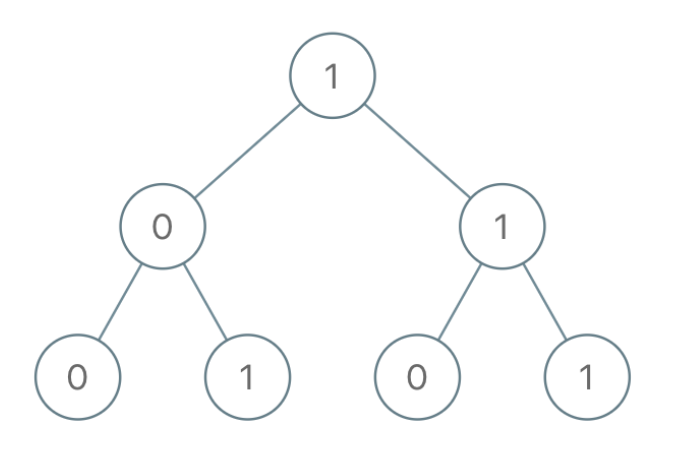给出一棵二叉树,其上每个结点的值都是 0 或 1 。每一条从根到叶的路径都代表一个从最高有效位开始的二进制数。
例如,如果路径为 0 -> 1 -> 1 -> 0 -> 1,那么它表示二进制数 01101,也就是 13 。
对树上的每一片叶子,我们都要找出从根到该叶子的路径所表示的数字。
返回这些数字之和。题目数据保证答案是一个 32 位 整数。
示例 1:
输入:root = [1,0,1,0,1,0,1]
输出:22
解释:(100) + (101) + (110) + (111) = 4 + 5 + 6 + 7 = 22
示例 2:
输入:root = [0]
输出:0
提示:
树中的节点数在 [1, 1000] 范围内
Node.val 仅为 0 或 1
/*** Definition for a binary tree node.* public class TreeNode {* int val;* TreeNode left;* TreeNode right;* TreeNode() {}* TreeNode(int val) { this.val = val; }* TreeNode(int val, TreeNode left, TreeNode right) {* this.val = val;* this.left = left;* this.right = right;* }* }*/class Solution {int res = 0;String s = "";public int sumRootToLeaf(TreeNode root) {dfs(root);return res;}void dfs(TreeNode root) {if (root.left == null && root.right == null) {s += root.val;int n = s.length();int tem = 0;for (int i = 0; i < n; ++i)tem += (s.charAt(i) - '0') * Math.pow(2, n - i - 1);res += tem;return;}s = s + root.val;if (root.left != null) {dfs(root.left);s = s.substring(0, s.length() - 1);}if (root.right != null) {dfs(root.right);s = s.substring(0, s.length() - 1);}}}
/*** Definition for a binary tree node.* public class TreeNode {* int val;* TreeNode left;* TreeNode right;* TreeNode() {}* TreeNode(int val) { this.val = val; }* TreeNode(int val, TreeNode left, TreeNode right) {* this.val = val;* this.left = left;* this.right = right;* }* }*/class Solution {public int sumRootToLeaf(TreeNode root) {return dfs(root, 0);}int dfs(TreeNode root, int cur) {int res = 0, newCur = (cur << 1) + root.val;if (root.left != null) res += dfs(root.left, newCur);if (root.right != null) res += dfs(root.right, newCur);return root.left == null && root.right == null ? newCur : res;}}

